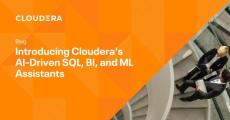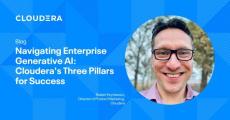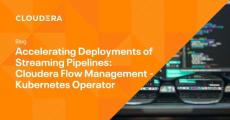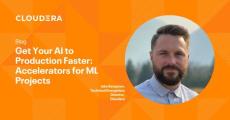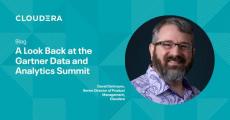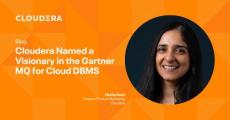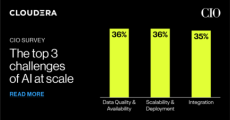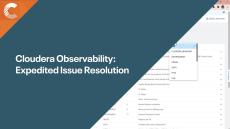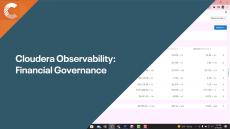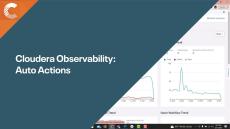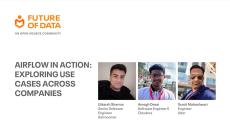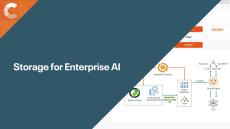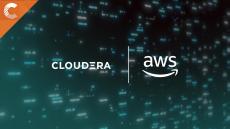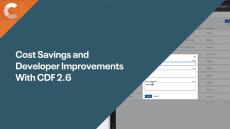|
By Wim Stoop
Hybrid cloud plays a central role in many of today’s emerging innovations—most notably artificial intelligence (AI) and other emerging technologies that create new business value and improve operational efficiencies. But getting there requires data, and a lot of it. More than that, though, harnessing the potential of these technologies requires quality data—without it, the output from an AI implementation can end up inefficient or wholly inaccurate.
|
By Robert Hryniewicz
In the last couple of years, AI has launched itself to the forefront of technology initiatives across industries. In fact, Gartner predicts the AI software market will grow from $124 billion in 2022 to $297 billion in 2027. As a data platform company, Cloudera has two very clear priorities. First, we need to help customers get AI models based on trusted data into production faster than ever.
|
By Robert Hryniewicz
Generative AI (GenAI) has taken the world by storm, promising to revolutionize industries and transform the way businesses operate. From generating creative content to automating complex tasks, the potential applications of GenAI are vast and exciting. However, implementing GenAI in an enterprise setting comes with its own set of challenges. At Cloudera, we understand the complexities of enterprise GenAI adoption.
|
By Chris Joynt
Organizations are challenged today to become both more data driven and more nimble to adapt quickly to changing conditions. These challenges are the driving forces behind much of their digital transformation or “modernization” efforts.
|
By Jacob Bengtson
One of the worst-kept secrets among data scientists and AI engineers is that no one starts a new project from scratch. In the age of information there are thousands of examples available when starting a new project. As a result, data scientists will often begin a project by developing an understanding of the data and the problem space and will then go out and find an example that is closest to what they are trying to accomplish.
|
By David Dichmann
Artificial intelligence (AI) is something that, by its very nature, can be surrounded by a sea of skepticism but also excitement and optimism when it comes to harnessing its power. With the arrival of the latest AI-powered technologies like large language models (LLMs) and generative AI (GenAI), there’s a vast amount of opportunities for innovation, growth, and improved business outcomes right around the corner. All of that technology, though, depends on data to be successful.
|
By Joe Rodriguez
Regulations often get a bad rap. You may have heard the old idiom “cut the red tape” which means to circumvent obstacles like regulations or bureaucracy. But in many – if not most )– cases the underlying need for regulations outweighs the burden of compliance.
|
By Natalia Belaya
It’s been said that the Federal Government is one of, if not the largest, producer of data in the United States, and this data is at the heart of mission delivery for agencies across the civilian to DoD spectrum. Data is critical to driving the innovation and decision-making that improves services, streamlines operations and strengthens national security.
|
By Navita Sood
We’re excited to share that Gartner has recognized Cloudera as a Visionary among all vendors evaluated in the 2023 Gartner® Magic Quadrant™ for Cloud Database Management Systems. This recognition underscores Cloudera’s commitment to continuous customer innovation and validates our ability to foresee future data and AI trends, and our strategy in shaping the future of data management.
|
By Abhas Ricky
At a time when AI is exploding in popularity and finding its way into nearly every facet of business operations, data has arguably never been more valuable. More recently, that value has been made clear by the emergence of AI-powered technologies like generative AI (GenAI) and the use of Large Language Models (LLMs).
|
By Cloudera
We have bundled the collective Cloudera support teams, implementation skill and experience into our Observability platform resulting in our framework called validations. This framework offers a clear and detailed view of potential issues within your Cloudera Environment enabling you to fix it internally. Based on years of Cloudera support experience, we identified over 400 and growing issues our customers have encountered frequently, and provide remedies. This framework also provides detailed information to provide to our support team should this issue require a more complex solution.
|
By Cloudera
Managing and forecasting cluster resource consumption costs is a complex task. Inefficient resource allocations and usage can lead to budget overruns and unexpected expenses. The challenge lies in gaining comprehensive insights into your resource consumption across different regions, departments, and user groups. It's also crucial for accurate financial planning. Cloudera Observability provides powerful financial governance capabilities to tackle these challenges effectively by providing unparalleled insight and control over your resource consumption and costs.
|
By Cloudera
Firas Yasin, Global Alliance Manager of AI/ML at RedHat, introduces the RedHat and Cloudera partnership. Firas shares that customers are often missing the combination of security, scalability and support when deploying open-source solutions for their end-to-end data lifecycles. In this video, Firas highlights that together with RedHat OpenShift and Cloudera Data Platform, customers can achieve security and scalability through the joint solution, in addition to catalyzing on RedHat and Cloudera’s unrivaled support offerings.
|
By Cloudera
Cloudera Observability provides the ability to define system rules and automate the appropriate action when those rules are broken through Auto Actions. This prevents for example that any one , query or job monopolizes the system, thereby impacting overall system performance.
|
By Cloudera
Introduction to Apache Airflow: A brief overview for both beginners and enthusiasts. Best Practices and Use Cases: Learn from industry experts about optimizing your workflows and real-world use cases.
|
By Cloudera
Unlock data potential with Cloudera's Open Data Lakehouse powered by Apache Iceberg. Break silos, centralize security, and accelerate AI, BI, and machine learning projects. Collaboration made efficient. Learn more at cloudera.com.
|
By Cloudera
Ozone enables ingest, processing, exploration, efficient iterative training, and fine-tuning of LLMs that rely on huge structured and unstructured datasets. This demo illustrates that. We have deployed a CML AMP chatbot that uses an LLM, augmented with an existing knowledge base. The knowledge base is stored in Ozone and retrieved over S3.
|
By Cloudera
No matter where you are in your data journey, Cloudera and AWS can help maximize your insights – providing flexibility, scale, and governance.
|
By Cloudera
Join Ehrar Jameel, Head of Data and Analytics, as he demystifies the concept of data strategy in this enlightening snippet from our Art of Data Leadership series. In this segment, Ehrar delves into the fundamental question: What is a data strategy? Ready to delve deeper into the world of data leadership? Click here for the full Art of Data Leadership playlist and gain invaluable insights from Ehrar and other industry experts.
|
By Cloudera
As organizations look to decrease cloud costs and run more efficiently, Cloudera DataFlow 2.6 introduced several improvements like Zookeeper-less deployments, new storage profiles, improved suspend behavior and vertical scaling.
|
By Cloudera
Enterprises require fast, cost-efficient solutions to the familiar challenges of engaging customers, reducing risk, and improving operational excellence to stay competitive. The cloud is playing a key role in accelerating time to benefit from new insights. Managed cloud services that automate provisioning, operation, and patching will be critical for enterprises to leverage the full promise of the cloud when it comes to time to value and agility.
|
By Cloudera
The adoption of cloud computing in the financial services sector has grown substantially in the past three years on a global basis. Diversification of risk is always a key concern for financial institutions and the seeming safety of having a single cloud provider is not being properly measured from a systemic risk and operational risk perspective.
|
By Cloudera
This white paper provides a reference architecture for running Enterprise Data Hub on Oracle Cloud Infrastructure. Topics include installation automation, automated configuration and tuning, and best practices for deployment and topology to support security and high availability.
|
By Cloudera
A cloud-based analytics platform needs to be easy, unified, and enterprise-grade to meet the demands of your business. This white paper covers how Cloudera's machine learning and analytics platform complements popular cloud services like Amazon Web Services (AWS) and Microsoft Azure, and enables customers to organize, process, analyze, and store data at large scale...anywhere.
|
By Cloudera
The Modern Platform for Machine Learning and Analytics Optimized for Cloud.
|
By Cloudera
In the wake of the global financial crisis, the world has become much more interconnected and immensely more complex. As a result, you can no longer simply look at the past as an indicator of future trends. The financial services industry needs real-time insights into numerous interacting variables to make informed decisions.
- May 2024 (5)
- April 2024 (10)
- March 2024 (11)
- February 2024 (14)
- January 2024 (11)
- December 2023 (10)
- November 2023 (14)
- October 2023 (18)
- September 2023 (15)
- August 2023 (10)
- July 2023 (16)
- June 2023 (17)
- May 2023 (13)
- April 2023 (13)
- March 2023 (16)
- February 2023 (6)
- January 2023 (2)
- December 2022 (13)
- November 2022 (9)
- October 2022 (19)
- September 2022 (21)
- August 2022 (20)
- July 2022 (10)
- June 2022 (18)
- May 2022 (9)
- April 2022 (9)
- March 2022 (13)
- February 2022 (13)
- January 2022 (6)
- December 2021 (15)
- November 2021 (18)
- October 2021 (23)
- September 2021 (22)
- August 2021 (26)
- July 2021 (14)
- June 2021 (21)
- May 2021 (24)
- April 2021 (30)
- March 2021 (16)
- February 2021 (19)
- January 2021 (18)
- December 2020 (22)
- November 2020 (17)
- October 2020 (19)
- September 2020 (23)
- August 2020 (27)
- July 2020 (21)
- June 2020 (11)
- May 2020 (22)
- April 2020 (18)
- March 2020 (14)
- February 2020 (8)
- January 2020 (13)
- December 2019 (3)
- November 2019 (1)
- October 2019 (3)
- September 2019 (1)
- August 2019 (2)
- July 2019 (5)
- May 2019 (2)
- April 2019 (1)
- March 2019 (2)
- February 2019 (1)
- January 2019 (3)
- December 2018 (3)
- November 2018 (2)
- September 2018 (7)
- August 2018 (6)
- July 2018 (3)
- June 2018 (3)
- May 2018 (2)
- March 2018 (1)
Cloudera delivers the modern platform for machine learning and analytics optimized for the cloud. Imagine having access to all your data in one platform. The opportunities are endless. We enable you to transform vast amounts of complex data into clear and actionable insights to enhance your business and exceed your expectations.
The right products for the job:
- Enterprise Data Hub: Operate with confidence—thanks to comprehensive security and governance—while at the same time enabling unrivaled self-service performance at extreme scale. All in an enterprise-grade solution that lets you run anywhere, on-premises or in hybrid- and multi-cloud environments.
- Data Science Workbench: Accelerate machine learning from research to production with the secure, self-service enterprise data science platform built for the enterprise.
- Data Warehouse: A modern data warehouse that delivers an enterprise-grade, hybrid cloud solution designed for self-service analytics.
- Data Science & Engineering: Cloudera Data Science provides better access to Apache Hadoop data with familiar and performant tools that address all aspects of modern predictive analytics.
- Altus Cloud: The industry’s first machine learning and analytics cloud platform built with a shared data experience.
The world’s leading organizations choose Cloudera to grow their businesses, improve lives, and advance human achievement.



